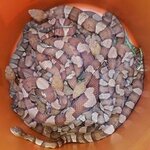

Hood County residents should be on their toes as the rise in temperatures will likely lead to more snakes being out and about within the community.
Mark Pyle, president of the DFW Herpetological Society, shared that snakes don’t generate their own heat and because of that they heavily rely on the sun to keep warm. When snakes cool down, they become inactive, and when outside temperatures start to rise, their bodies begin to warm up.
According to Pyle, who has been involved in reptile education for 28 years, the most common snake in Hood County is the western rat snake, also known as Pantherophis Obsoletus. These snakes are non-venomous and are good for controlling unwanted rodents. He shared that the county also has a lot of water snakes, both diamond-backed and plain-bellied — both are nonvenomous. There is also the Brazos water snake, listed as a threatened species in Texas, which makes it illegal to kill. The Brazos water snake is also harmless.
Pyle said the most common venomous snake in Hood County is the broad banded copperhead. These are reddish orange banded snakes that average around two feet in length although they can be as long as three feet. Broad banded copperheads are most often seen from May to September and typically come out around dusk. Pyle added that in one night, he found 28 of the snakes within one hour.
The western diamondback rattlesnake can also be found in Hood County; Pyle called it the “iconic” rattlesnake often seen in western movies.
Pyle is part of the Hood County Snake Relocation group created last September.
“The goal is to keep people safe and to educate people on how to minimize attracting snakes to their property,” Pyle said. “The way to keep them out of your yard is to cut the grass short, trim bushes 10 to 12 inches off the ground, use very little mulch in flower beds and keep plants to a minimum, remove any clutter or ground cover, and also remove any rodent or food sources such as outside pet food and bird feeders.”
Pyle noted there has never been a documented cottonmouth in Hood County, but there are lots of misidentifications.
“If you encounter a snake, it’s best not to panic. If you feel you’re in danger, step back the way you came to reduce the chance of stepping on a different one you didn’t see,” Pyle shared. “Once you are at a safe distance, take a photo and post it in the Facebook group ‘What Kind of Snake is This North Texas, Educational Group’ (created by Pyle) for a quick identification. You can also ask questions and ask for help relocating if needed.”
He shared that many Hood County residents are familiar with this group; more than 190,000 people have joined it. He also has a website — texassnakeid.com — that shares tons of information on snakes across Texas.
Those who need a snake to be relocated can visit the Hood County Snakes Linktree at linktr.ee/hoodcountysnakes or call 682-500-1566.